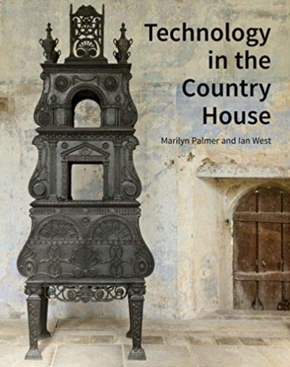Technology in the Country House

|
| Technology in the Country House, Marilyn Palmer and Ian West, Historic England and National Trust, 2016, 205 pages, 250 illustrations. |
The technology referred to in the title includes the supply of water and sanitation, the production of energy, the preparation and storage of food, transportation systems such as lifts and railways, and the lighting, heating and ventilation of country houses. Remnants of earlier forms of technology can be found in all types of historic buildings, from cottages to mills, but the systems are rarely sufficiently intact for conservators and heritage professionals to make sense of what they have found or to evaluate their significance. However, large country estates often retain relatively intact examples because by the early 20th century most owners were struggling to maintain and update their vast rambling mansions.
Relevant technological developments are considered in the wider context of the period. For example, the chapter on lighting starts by explaining that it was not until the late 19th century that most people saw any benefit from the improvement in technology. Even then, most ordinary people went to bed at dusk and rose at dawn because artificial lighting was too expensive. The chapter goes on to consider each key development chronologically. Country house collections provide the authors with examples of sconces, candelabra and the first significant lighting improvement, the Argand oil lamp in the 1780s.
Architectural fixtures and fittings which survive are also used to illustrate the development of successive technologies, such as those of the lamp room at Castle Coole, a National Trust property near Enniskillen, where a plunge bath was used for filling the oil lamps, with a drain board above. The introduction of gas is outlined, from its first significant use in 1805 for the lighting of cotton mills, to the development of gasworks in towns and country estates. Here the legacy includes not only a variety of light fittings and related services, but also small buildings to house the retorts and purifiers for making coal gas, and the gas holders themselves.
As well as domestic technologies, the book encompasses the gardens and estates where horse power, water power and then steam engines were used to power everything from sawmills and threshing machines to water pumps. These developments are considered in terms of both the technological advances of the period and the interests and requirements of the country house owners and their advisors. Although the focus is on the technological developments rather than the sociological changes of the period, the broader perspective means that the book will fit as comfortably on the shelves of conservators as in the libraries of historians.
‘Technology in the Country House’ brings together the findings of extensive investigation and research started almost 20 years ago by the late Nigel Seeley to record all early mechanical, electrical, gas and water systems on the National Trust’s estate. Following his death in 2004, this data formed the basis for a new project with a broader scope led by Marilyn Palmer, professor of archaeology at Leicester University. With the support of English Heritage, the project expanded to include the country houses of other organisations and private estates. The result is a book which will be invaluable to everyone involved in conserving historic buildings.
This article originally appeared as ‘Systems for living’ in IHBC's Context 159 (Page 60), published in May 2019. It was written by Jonathan Taylor, editor of the Building Conservation Directory.
--Institute of Historic Building Conservation
[edit] Related articles on Designing Buildings
- Architecture of the industrial revolution.
- Building services.
- Conservation.
- Energy efficiency for the National Trust.
- English Heritage.
- JW Evans silverware factory.
- IHBC articles.
- National Trust.
- Nineteenth century building types.
- Noble Ambitions: the fall and rise of the post-war country house.
- Replacing lanterns and overthrows in Great Pulteney Street.
- Shrewsbury Flaxmill Maltings.
- The Angel Awards.
- The Institute of Historic Building Conservation.
- The redevelopment of Leicester's sewerage system by Joseph Gordon.
- The Victorian Society's top 10 endangered buildings 2019.
IHBC NewsBlog
Old Sarum fire in listed (& disputed) WW1 Hangar - Wiltshire Council has sought legal advice after fire engulfed a listed First World War hangar that was embroiled in a lengthy planning dispute.
UK Antarctic Heritage Trust launches ‘Virtual Visit’ website area
The Trust calls on people to 'Immerse yourself in our heritage – Making Antarctica Accessible'
Southend Council pledge to force Kursaal owners to maintain building
The Council has pledged to use ‘every tool in the toolbox’ if urgent repairs are not carried out.
HE’s Research Magazine publishes a major study of the heritage of England’s suburbs
The article traces the long evolution of an internal programme to research 200 years of suburban growth
IHBC Context 183 Wellbeing and Heritage published
The issue explores issues at the intersection of heritage and wellbeing.
SAVE celebrates 50 years of campaigning 1975-2025
SAVE Britain’s Heritage has announced events across the country to celebrate bringing new life to remarkable buildings.
IHBC Annual School 2025 - Shrewsbury 12-14 June
Themed Heritage in Context – Value: Plan: Change, join in-person or online.
200th Anniversary Celebration of the Modern Railway Planned
The Stockton & Darlington Railway opened on September 27, 1825.
Competence Framework Launched for Sustainability in the Built Environment
The Construction Industry Council (CIC) and the Edge have jointly published the framework.
Historic England Launches Wellbeing Strategy for Heritage
Whether through visiting, volunteering, learning or creative practice, engaging with heritage can strengthen confidence, resilience, hope and social connections.














